The Thermo Scientific™ ARL™ SMS-2300 Robotics-Based Automation for OES or XRF is compact, ultra-fast, and easy to install. It uses innovative automation technology to meet the needs of modern metals industry laboratories. The ARL SMS-2300 Automated Metals System is built and maintained in accordance with ISO 9001 standards, along with reputable metals analyzers.
Thermo Scientific can fully offer and support instrument and laboratory workflow automation solutions since they are the designers of the spectrometers that produce the analyses, which are the only deliverables to the process.
A Proven Automation Solution with Increased Performance
The ARL SMS-2300 system results from 40 years of expertise in providing laboratory workflow automation solutions. Over 1,000 robotized Thermo Scientific optical emission (OES) and X-Ray fluorescence (XRF) spectrometers provide feedback for metals applications globally.
The ARL SMS-2300 system delivers exceptional performance, dependability, and durability in even the most demanding metal applications. This spectrometer automation solution streamlines sample preparation and processing, resulting in faster turnaround times.
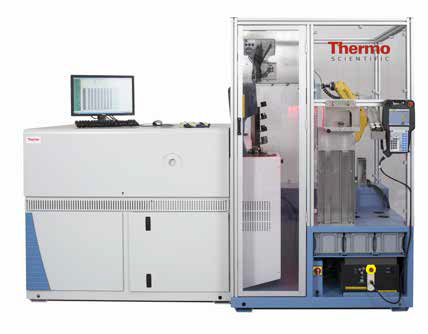
Image Credit: Thermo Fisher Scientific - Elemental and Phase Analysis
A Real Opportunity for the Metals Industry
Due to tighter quality standards, specifications for metal products are becoming increasingly demanding. As a result, having the capacity to conduct precise analytical quality control is essential now more than ever.
Revisions to manufacturing processes and quality control are crucial due to competitive demand for greater productivity and reduced production costs. The ARL SMS-2300 system is the best automation option available today for improving the production quality control operation.
Increased Efficiency
The ARL SMS-2300 system allows for rapid and consistent sample preparation and analysis without the need for human interaction, substantially decreasing operations and analysis costs.
- Results are provided faster, leading to increased production turnover and eliminating bottlenecks.
- Qualified laboratory professionals can be freed from routine responsibilities.
Better Analysis Dependability and Quality
All samples are processed using pre-defined protocols to ensure consistency and reproducibility. This eliminates human variables, mistakes, and subjective elements that could affect analysis results, making the results more accurate and reproducible.
Automatic monitoring of instruments ensures continuous control over performance. Advanced analysis processes might be challenging to conduct with a manual instrument but are applied consistently.
A Very Rapid Payback
Faster, more reliable, and less costly analyses result in a quick return on investment. A repeatable process reduces rework and downtime, improves measurement accuracy, boosts productivity, and leads to higher metal production.
Easy Integration into the Specific Environment
The automated ARL metals system can be used in centralized laboratories and production shop floors.
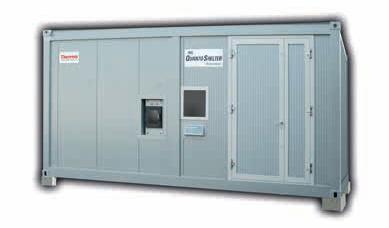
The ARL QuantoShelter Automated Metals Analyzer. Image Credit: Thermo Fisher Scientific - Elemental and Phase Analysis
In situ Analysis
The Thermo Scientific ARL QuantoShelter Automated Metals Analyzer is the best option. This automated ARL metals system can be used in centralized laboratories and production floors and is excellent for production-floor analysis. The “lab-in-a-box” container houses the whole system, including sample preparation.
The system functions similarly to a process sensor or on-stream analyzer, reducing sample transport delays by bringing the laboratory to the samples rather than vice versa.
The ARL QuantoShelter Automated Metals Analyzer is especially useful in production where protected spaces for the system are lacking.
Laboratory Applications
Integrating manual and automated air tubes is simple since all samples are introduced into the ARL SMS-2300 system rather than the sample preparation unit. To simplify automated air tube systems, incoming samples can be momentarily held in the SMS system and processed according to their priority. This enables big automated laboratories to operate at maximum efficiency and save expenses while keeping commissioning periods to a minimum.

ARL SMS-2300 robot. Image Credit: Thermo Fisher Scientific - Elemental and Phase Analysis
Latest Robotics Technology
The robot that comes with the ARL SMS-2300 system is made by FANUC, the world’s leading manufacturer of industrial robots. This medium-sized robot is mounted on a chassis connected to the ARL Metals system. It has an arm length of 550 mm, a gripper, and six moving axes.
Metallic samples and standards weighing up to 1.5 kg can be moved at high speeds with a repeatability of ± 0.03 mm.
Standard manufacturing sample weights result in less solicitation and wear, increasing dependability and longevity. The ARL SMS-2300 system’s robot requires little maintenance due to its use of high-precision brushless AC-Servo motors and internal cabling.
A Powerful, Multi-Purpose, and Entirely Customizable Product
The system offers unparalleled operational flexibility and capability for a typical product. The customization capabilities enable users to handle a wide range of applications without relying on one-off solutions that might be difficult to maintain.
After installation, the system is easily adaptable to new or changing requirements, which are sometimes challenging to foresee and anticipate.
High-speed and Intelligent Sample Processing
The automated ARL Metals Analyzer is designed with multitasking to minimize sample turnaround times at its core:
The system consists of the spectrometer, SMS system, and preparation machine, each operating separately and concurrently with the others.
While additional samples are being presented or examined, samples are being prepared. The “brain” of the system, the ARL automation workstation, systematically optimizes sample turnaround times.
The spectrometer cleans electrodes and adjusts the instrument stand simultaneously without relying on the robot of the ARL SMS-2300 system. When the instrument is busy, the preparation machine automatically uses the waiting positions for prepared samples to free itself to handle the next sample.
Top Class Performance and Uptime
Easy Sample Registration and Introduction
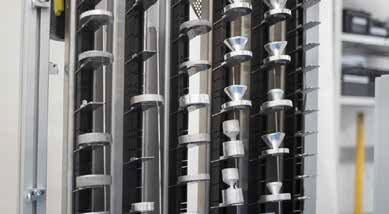
Temporary storage of incoming samples. Image Credit: Thermo Fisher Scientific - Elemental and Phase Analysis
There are several ways to make the introduction and registration of samples easier. Production samples can be registered manually. To reduce time and prevent mistakes, registering online using other computers, such as laboratory management systems or process computers, is also feasible.
The ARL SMS-2300 system always introduces samples directly before preparing them, eliminating the requirement for electromechanical sample introduction magazines and transfer systems.
The robot can temporarily store incoming samples in a random access, fixed, universal magazine to handle high cadences.
Instead of processing these samples in order of arrival, they are treated automatically according to their unique priorities. The production samples that are awaiting processing are visible in monitoring.
Open Architecture for Sample Preparation
An automated metals analyzer’s ability to prepare samples of the highest caliber, consistency, and dependability is crucial to system uptime and analytical performance. Sample preparation has changed significantly in the last several years, with milling emerging as the go-to method for metal applications.
Thermo Scientific provides various sample preparation options, fully conscious of the market’s expectation that consumers have a choice of brands and solutions. This allows customers to choose the best option based on their needs, tastes, and financial constraints.
Tightly Integrated Sample Preparation
The ARL SMS-2300 system’s robot provides direct access to most sample preparation devices for loading and unloading. This lowers sample turnaround times and removes extraneous hardware.
The system requires little floor space and small distances between components, allowing for quick operation without compromising accessibility for maintenance. This allows easy access to the sample preparation equipment for maintenance or semiautomatic operations, eliminating the need to turn off the robotic system.
More Reliable, Accurate, and Reproducible Analyses
The global system’s dependability is similar to the line's weakest link. The automatic system's components are carefully selected based on rigorous quality requirements, and the SMS software undergoes extensive testing before deployment.
- The ARL iSpark, which has its own PC and the OXSAS analysis software, is the system's central component. The SMS robot instantly clamps the prepared sample onto the spectrometer platform, which is automatically clamped onto the stand table during the measurement process.
- The robot of the ARL SMS-2300 system automatically and precisely moves the sample between sparks.
- Bad sparks are instantly rejected. Bad burns can be found early in the pre-integration phase, further shortening processing times for challenging samples.
- The stand table and the electrode are cleaned automatically in hidden time.
- The robot grasped and handled every distinct production, setup, control sample, and type standard as a unique sample to guarantee the highest level of sample manipulation reliability.
The findings are automatically communicated, and samples are sorted and stored in containers after analysis. Even those that cannot be analyzed can be filed chronologically on a chute for manual examination.
Sample Surface Management
The analysis surface of each standard is designed to conduct as many sparks as possible without requiring re-preparation. This saves money on reference samples and frees up time for processing production samples. Spark positions are user-defined for each sample and standard.
Automation to Advance Quality Control Capabilities
Instrument Performance Monitoring
It is essential to guarantee that the automated metals analyzer consistently produces high-quality results to minimize waste and rework during production.
Statistical process control, or SPC, routinely examines and processes control samples to identify irregularities. The system initiates automatic instrument standardization as needed, and alarms are generated when manual actions are needed to keep the system from losing control.
The instrument's analytical performance can be recorded and shown in control charts (SPC-Full option) for certification without operator participation. These SPC tools can be automatically deployed to the manufacturing process to quickly analyze product quality and identify potential changes.
Type standards are provided to address discrepancies in response between the composition of specific alloys and instrument calibration.
When trace elements need to be assessed after alloy samples, conditioning samples can be examined to eliminate any potential stand contamination.
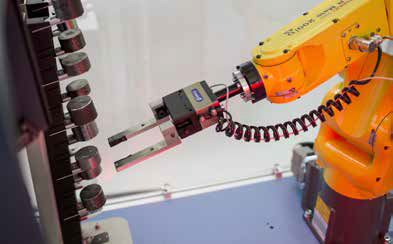
ARL SMS-2300 Setting-up Samples, Control samples, and Type standardization sample. Image Credit: Thermo Fisher Scientific - Elemental and Phase Analysis
The fixed and universal ARL SMS-2300 magazine is used for setup, control samples, and type standards. It can store up to 11 standards with various diameters (147 standards are an option). These standards are automatically updated during downtime, before analysis, or at an operator’s request.
The SMS robot automatically rotates the standards by about 30° in advance to mitigate sample inclination issues and minimize bias in the replacement over time.
Full Compliance with Safety Regulations and Audit Trail
The safety enclosure of the ARL SMS-2300 Automated Metals system has been constructed in compliance with the relevant CE certification standards. The system conforms to electromagnetic rules and guidelines as well as robotics applications.
In addition to allocating system resources, user accounts guard the system from unauthorized modifications.
Events of interest can be saved on disk and shared with other computers to guarantee the traceability of the quality control operations.
Three superimposed color lights (red, blue, and green) permanently display the system status (optional).
Digital signals are an optional means of informing external user-supplied equipment (such as lighting and acoustic devices) about specific occurrences.
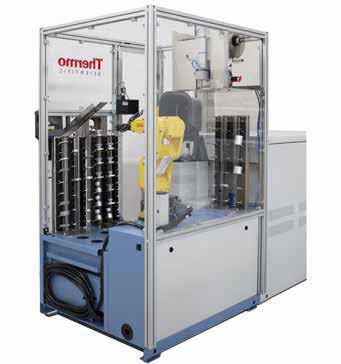
Safety enclosure with access doors. Image Credit: Thermo Fisher Scientific - Elemental and Phase Analysis